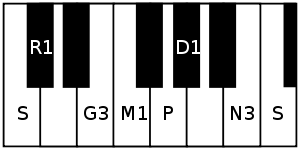Mayamalavagowla
| Carnatic music |
|---|
Tanjavur-style Tambura |
| Concepts |
| Compositions |
| Instruments |
|
Mayamalavagowla (pronounced māyāmāḻavagauḻa), is a raga of Carnatic Music (musical scale of South Indian classical music). It is classified as 15th melakarta raga under Venkatamakhin's melakarta system. Originally known as malavagowla, "maya" was prefixed to it after the advent of the scheme of the 72 melas. The number 15 was assigned to it following the Katapayadi sankhya system. This is a morning raga.
Structure and Lakshana

Venkatamakhin defines its lakshana thus:
पूर्णो माळवगोळाख्यः स ग्रहो गीयते सदा
pūrṇo māḻavagouḻākhyah sa graho gīyate sadā
Mayamalavagowla is the 3rd raga in the 3rd chakra, Agni. Its mnemonic name is Agni-Go. Its mnemonic phrase is sa ra gu ma pa dha nu.[1] Its ārohaṇa-avarohaṇa structure is as follows (see swaras in Carnatic music for details on below notation and terms):
The notes in this raga are shuddha rishabham, antara gandharam, shuddha madhyamam, shuddha dhaivatam and kakali nishadam. As it is a melakarta rāgam, by definition it is a sampurna rāgam (has all seven notes in ascending and descending scale). It is the shuddha madhyamam equivalent of Kamavardhini (also known as pantuvarali), which is the 51st in the melakarta scale.
The gamakas in the raga are unique in that conversely to the G-M relationship in Sankarabharanam, G is sung in oscillation (M,G M,G M,G) while M is held constant. There is no bold M-P gamaka as in Sankarabharanam as well. R and D are also usually sung in oscillation with S and P respectively, making the only constant notes S, M, and P. Of course, these rules are occasionally broken for effect (i.e. holding N flat before ascending to S).
Nature of Raga
This auspicious raga evokes śānta(peace) rasa and pathos. It creates a soothing effect. Suitable to sing at all times, particularly, the first yAMam (dawn). It is commonly used for beginners lessons such as Sarali Varisais or Sarali Svaras (Telugu), etc. Since it eschews vivadi swaras (relatively discordant notes), has a uniform distance between svara sthānas (relative position of notes) and has symmetry, they are easier to learn. It is an ancient rāgam and has been around for a long time.
It is a Sampurna raga. Also, it is a sarva svara gamaka varika rakti rāga. It has a large number of janya ragas (derived scales) assigned to it. This rāgam corresponds to Bhairav in Hindustani music.
It is also defined as a mūrcana kāraka méLa since it can be used for Graha bhedam on madhyamam and rishabham to result in Simhendramadhyamam and Rasikapriya respectively. Graha bhedam is the step taken in keeping the relative note frequencies same, while shifting the Shruti (or drone) to another note in the rāgam. For further details and an illustration refer Graha bhedam on Māyamālavagowla.
Janya ragams
Mayamalavagowla has quite a few janya ragams associated with it, of which Bowli, Jaganmohini, Gowla, Gowlipantu, Janaranjini, Lalita, Nadanamakriya, Revagupti, Saveri and Malahari are quite well known. See List of janya Ragas for a full list of janyas.
Popular compositions
All the basic swara exercises (Sarali, Janta, Daattu, etc.) are set to the Mayamalavagowla raga. These are learnt by beginners in Carnatic Music. It is commonly used in the basics, credited to Purandara Dasa's work in his time, when he did much work towards standardizing the teaching of Carnatic Music into a fully graded system. The first mini-songs (geetam) that are taught after the completion of basic exercises, are set to Malahari, a janya of Mayamalavagowla. Muthuswami Dikshitar's famous gouḻānta kritis (eight compositions with their raga names ending as gowla), on Goddess Nilothpalamba has māyāmāḻavagouḻa for one of them.
Some of the popular compositions in Mayamalavagowla are, Deva Deva composed by Swathi Thirunal and Adikkondar by Muthu Thandavar. A list of popular compositions in Mayamalalavagowla is as follows:
- Varnam- Sree Rajarajeswari
- Tulasī Daḻamulacē Saṃtōṣamuga - Tyagaraja in Telugu
- Meru samāna vīra - Tyagaraja in Telugu
- Dēvī Śri Tulasammā - Tyagaraja in Telugu
- Vidulaku Mrokkeda - Tyagaraja in Telugu
- Dēva Dēva Kalayaami - Swathi Thirunal
- Māyātīta Svarūpiṇi - Ponnaiyya Pillai (Direct Disciple of Muthuswami Dikshitar) in Sanskrit
- Śrināthādi Guruguho - Muthuswami Dikshitar (The very first composition of Muthuswami Dikshitar) in Sanskrit
- ŚhyĀmalĀmbikĒ pĀhimĀm - Dr. M. Balamuralikrishna
This raga has also been very popularly used in film music. Numerous well recognized songs have been set in this raga. Ilayaraja has composed many hit songs in this raga.[2]
References
- ↑ Ragas in Carnatic music by Dr. S. Bhagyalekshmy, Pub. 1990, CBH Publications
- ↑ http://aboutindianmusic.blogspot.com/2011/10/learning-about-indian-music-raga.html